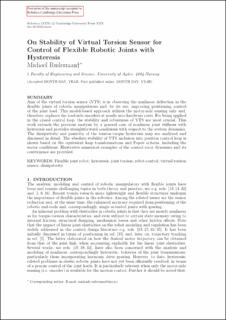| dc.contributor.author | Ruderman, Michael | |
| dc.date.accessioned | 2020-03-21T12:54:53Z | |
| dc.date.available | 2020-03-21T12:54:53Z | |
| dc.date.created | 2019-09-01T08:45:01Z | |
| dc.date.issued | 2019 | |
| dc.identifier.citation | Ruderman, M. (2019). On Stability of Virtual Torsion Sensor for Control of Flexible Robotic Joints with Hysteresis. Robotica. doi: | en_US |
| dc.identifier.issn | 1469-8668 | |
| dc.identifier.uri | https://hdl.handle.net/11250/2647940 | |
| dc.description | Author's accepted manuscript (postprint). | en_US |
| dc.description | This article has been published in a revised form in Robotica, http://doi.org/10.1017/S0263574719001358. This version is free to view and download for private research and study only. Not for re-distribution or re-use. © 2019 Cambridge University Press. | |
| dc.description | Available from 25/03/2020. | |
| dc.description.abstract | Aim of the virtual torsion sensor (VTS) is in observing the nonlinear deflection in the flexible joints of robotic manipulators and, by its use, improving positioning control of the joint load. This model-based approach utilizes the motor-side sensing only and, therefore, replaces the load-side encoders at nearly zero hardware costs. For being applied in the closed control loop, the stability and robustness of VTS are most crucial. This work extends the previous analysis by a general case of nonlinear joint stiffness with hysteresis and provides straightforward conditions with respect to the system dynamics. The dissipativity and passivity of the torsion-torque hysteresis map are analyzed and discussed in detail. The absolute stability of VTS inclusion into position control loop is shown based on the equivalent loop transformations and Popov criteria, including the sector conditions. Illustrative numerical examples of the control error dynamics and its convergence are provided. | en_US |
| dc.language.iso | eng | en_US |
| dc.publisher | Cambridge University Press | en_US |
| dc.rights | Attribution-NonCommercial-NoDerivatives 4.0 Internasjonal | * |
| dc.rights.uri | http://creativecommons.org/licenses/by-nc-nd/4.0/deed.no | * |
| dc.title | On Stability of Virtual Torsion Sensor for Control of Flexible Robotic Joints with Hysteresis | en_US |
| dc.type | Journal article | en_US |
| dc.type | Peer reviewed | en_US |
| dc.description.version | acceptedVersion | en_US |
| dc.rights.holder | © 2019 Cambridge University Press | en_US |
| dc.subject.nsi | VDP::Teknologi: 500 | en_US |
| dc.source.pagenumber | 14 | en_US |
| dc.source.journal | Robotica | en_US |
| dc.identifier.doi | 10.1017/S0263574719001358 | |
| dc.identifier.cristin | 1720324 | |
| cristin.qualitycode | 1 | |

